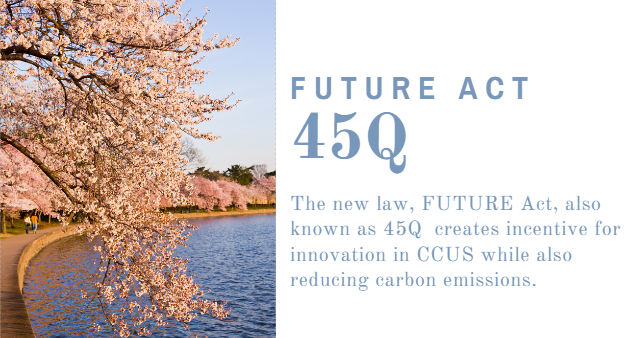Washington DC
 On February 9th the FUTURE Act passed Congress as part of the bipartisan budget deal and was signed in to law.
On February 9th the FUTURE Act passed Congress as part of the bipartisan budget deal and was signed in to law.
The bipartisan bill, often referred to as 45Q, was the talk of Washington, DC, during my trip there the following week. Stakeholders from all sides were looking forward to the new law incenting innovation for CCUS while also reducing carbon emissions.
In a recent Technology Review article, Julio Friedmann of the Energy Futures Initiative, who was previously principal deputy assistant secretary at the US Department of Energy’s Office of Fossil Energy, said “I think we’ll see dozens of [carbon-capture] projects appear in the next couple of years that could not have happened otherwise.”
What is the FUTURE Act?
The legislation derives its name, FUTURE as an acronmyn for: Furthering carbon capture, Utilization, Technology, Underground storage, and Reduced Emissions Act. Previously the CCS tax credit was for $20 per tonne (US dollars) of CO2 geologically stored and $10 for every tonne of CO2 utilized – such as with enhanced oil recovery; and this tax credit was capped at 75Mt. With the FUTURE Act, those numbers now increase, respectively to $50 and $35 with no cap which will provide certainty for developers. The window to begin projects that qualify for credits is within 6 years.
Supporters of the Act spanned the country (for a variety of statements of support, click here.) Including the Tri-State Generation and Transmission Association who were quoted to say,
“Advancing carbon capture technologies is essential for utilities to manage emissions and preserve affordable, reliable electricity for consumers.”
This is a sentiment I heard also from GOP Senate Staff. It appears critical to maintain a reliable baseload energy mix – and here in Saskatchewan Canada we know this; we have seen here that renewables are maximized when we utilize CCS.
Sharing Lessons Learned
Likewise support for the FUTURE Act came from the Democrat Senate Staff I was fortunate to meet with. Understanding how environmental regulations play into CCS projects in Canada was of interest. In the US, CO2 is treated like a toxic substance, and injecting it into the ground for storage is an obstacle that may be able to be remedied through further understanding of how this process works in Saskatchewan. Comprehensive measurement, monitoring, verification and reporting programs have shown effective and long-term environmental management tools to date in both the EOR and storage processes.
We look forward to working with the US on advancing CCUS deployment. We hope our lessons learned from SaskPower's Boundary Dam Project will help US projects start from a higher level of understanding that will, in turn, limit many of the costs and risks that could be incurred from going it alone.


-cropped-cropped.jpg)